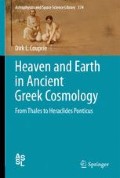Abstract
The tilting of the axis of the heavens must have been one of the big riddles for the ancients who studied the skies. Why does it look as if the stars turn around a point in the northern region of the heavens, and not around the zenith? In other words, why is the axis of the heavens tilted? One would expect myths to be told about this phenomenon. However, I know of only one, from ancient China, where, just as in Presocratic Greece, people believed that the earth is flat. The legendary hero Kung-kung struggled with the also legendary emperor Chuan Hsü about the sovereignty of the empire. In great anger, he threw a mountain that shattered the pillars of the heavens. Since that time, the heavens are inclined toward the north-west (see Needham 1959: 21). It is strange that the heavens are said to tilt in the direction of the north-west instead of the north, as we might expect. Perhaps one source gives a reason for this anomaly, as there it is added: “the earth does not fill the South-East, so the rivers and the rain floods find their home there” (Graham 1990: 96). Broadly speaking, one might say that the great Chinese rivers flow to the south-east. Here, the same identification of the tilting of the heavens with a dip of the earth as in Presocratic Greece, which I discuss below, seems to be the case.
Access this chapter
Tax calculation will be finalised at checkout
Purchases are for personal use only
Notes
- 1.
At the time of the Presocratics, due to the precession, the Polar star was much farther away from the north pole of the heavens than in our times. Around 500 B.C., Kochab, one of the stars of Ursa Minor, was the nearest star to the pole, at about 7°, whereas in our days Polaris is at no more than 41′ distance from the pole.
- 2.
See also Rovelli: “la hauteur du soleil varie avec la latitude (…) l’interprétation chinoise: la Terre est plate et la variation est due à la faible distance du soleil” (2009c: 131, subscription of Fig. 18, left).
- 3.
- 4.
A theoretical possibility would be that originally the celestial axis is thought of as lying in the plane of the surface of the flat earth, and that later on it was lifted up onto its present angle. This, however, would not be in accordance with the sources, which speak of a tilt, and, in the case of Anaxagoras, explicitly of an originally upright position of the celestial axis.
- 5.
On a flat earth, the tilting of the celestial axis will only by accident be the same as the obliquity of the ecliptic, viz., when the center of the flat earth is thought to be at what we would call 23.5° latitude, for instance at Syene. Only in that case the celestial axis on a flat earth will lie in the plane of the ecliptic.
- 6.
References
Dicks, D.R. 1970. Early Greek Astronomy to Aristotle. Ithaca, NY: Thames and Hudson.
Diels, Hermann. 1879. Doxographi Graeci. Berlin: Walter de Gruyter & Co.
Dreyer, John L.E. 1953. A History of Astronomy from Thales to Kepler. New York: Dover Publications, Inc. (Facs. reprint of: History of the Planetary Systems from Thales to Kepler. Cambridge: Cambridge University Press, 1905).
Dümmler, Ferdinand. 1889. Akademika, Beiträge zur Literaturgeschichte der sokratischen Schulen. Gießen: Ricker (repr. 1987, Osnabrück: Biblio Verlag).
Dumont, Jean-Paul. 1988. Les Présocratiques. Paris: Gallimard.
Furley, David J. 1987. The Greek Cosmologists, Vol. I: The Formation of the Atomic Theory and Its Earliest Critics. Cambridge: Cambridge University Press.
Furley, David J. 1989. Cosmic Problems. Essays on Greek and Roman Philosophy of Nature. Cambridge: Cambridge University Press.
Gershenson, Daniel E. and Daniel A. Greenberg. 1964. Anaxagoras and the Birth of Physics. New York: Blaisdell Publishing Company.
Graham, Angus C., transl. 1990. The Book of lieh-tzû: A Classic of the Tao. New York: Columbia University Press.
Guthrie, William K.C. 1965. A History of Greek Philosophy, II. The Presocratic Tradition from Parmenides to Democritus. Cambridge: Cambridge University Press.
Heath, Thomas. 1913. Aristarchus of Samos. The Ancient Copernicus. Oxford: Clarendon Press.
Heidel, William Arthur. 1933. The Heroic Age of Science. Baltimore: Williams & Wilkins Company.
Kahn, Charles H. 1970. On Early Greek Astronomy. Journal of Hellenic Studies 90: 99–116.
Kingsley, Peter. 1995. Ancient Philosophy, Mystery, and Magic. Empedocles and Pythagorean Tradition. Oxford: Oxford University Press.
Needham Joseph. 1959. Science and Civilisation in China, Vol. 3: Mathematics and the Sciences of the Heavens and the Earth. Cambridge: Cambridge University Press.
Panchenko, Dmitri. 1999. Who Found the Zodiac? Antike Naturwissenschaft und ihre Rezeption 9: 33–44.
Rovelli, Carlo. 2009c. Anaximandre de Milet ou la naissance de la pensée scientifque. Paris: Dunod.
Wöhrle, Georg. 1993. Anaximenes aus Milet. Die Fragmente zu seiner Lehre. Stuttgart: Franz Steiner Verlag.
Zeller, Edward and Wilhelm A. Nestle. 1920. Die Philosophie der Griechen in ihrer geschivhtliche Entwicklung. 1. Teil, 2. Hälfte: Allgemeine Einleitung, Vorsokratische Philosophie (6th edition). Leipzig: Reisland.
Author information
Authors and Affiliations
Rights and permissions
Copyright information
© 2011 Springer Science+Business Media, LLC
About this chapter
Cite this chapter
Couprie, D.L. (2011). The Riddle of the Celestial Axis. In: Heaven and Earth in Ancient Greek Cosmology. Astrophysics and Space Science Library, vol 374. Springer, New York, NY. https://doi.org/10.1007/978-1-4419-8116-5_5
Download citation
DOI: https://doi.org/10.1007/978-1-4419-8116-5_5
Published:
Publisher Name: Springer, New York, NY
Print ISBN: 978-1-4419-8115-8
Online ISBN: 978-1-4419-8116-5
eBook Packages: Physics and AstronomyPhysics and Astronomy (R0)

